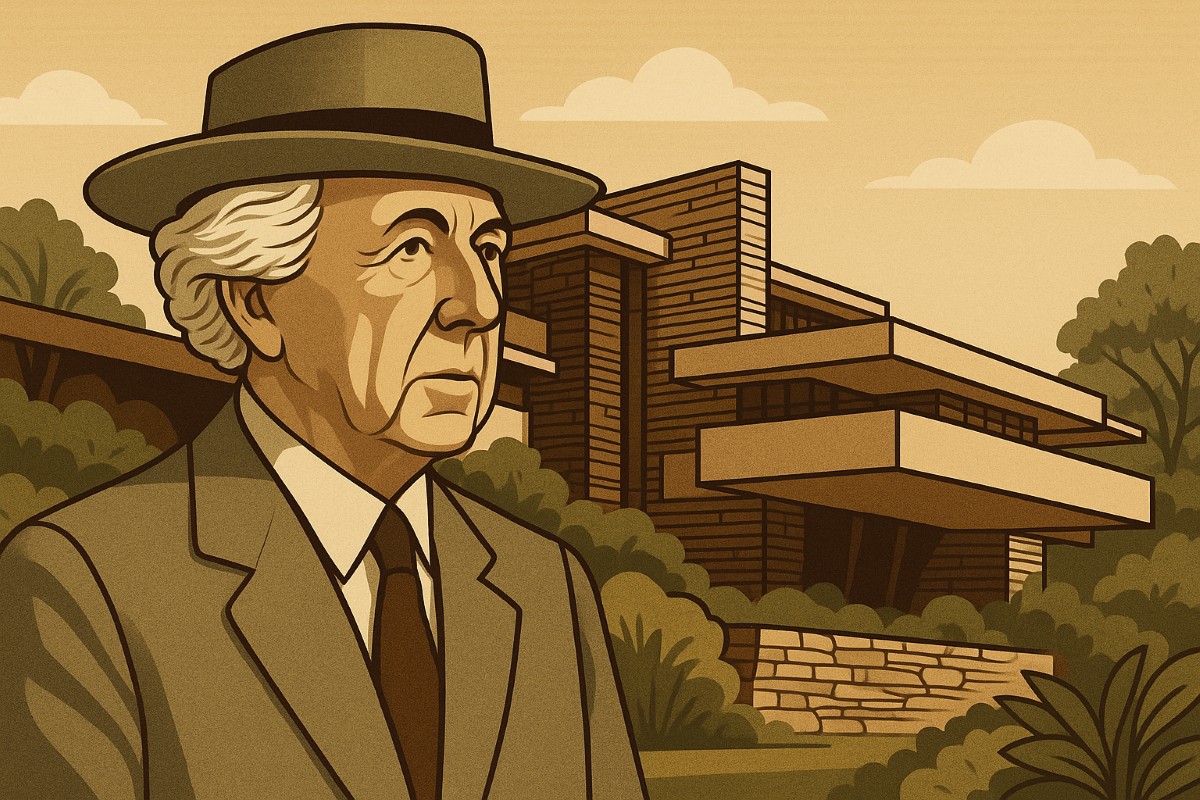Who was Frank Lloyd Wright? This question often arises when discussing the pioneers of American architecture. Renowned for his visionary designs and organic architecture philosophy, Wright revolutionized how buildings interact with nature, space, and the people who occupy them. From Fallingwater to the Guggenheim Museum, his work redefined 20th-century design and continues to influence architects around the globe.
Frank Lloyd Wright wasn’t just a builder but a thinker, teacher, and innovator. He pushed boundaries with new materials and spatial concepts, championing harmony between human environments and the natural world. Over a career that spanned over seven decades, he designed over 1,000 structures, of which more than 500 were completed.
In this article, we will explore Wright’s early life, architectural philosophy, landmark projects, and lasting legacy. We’ll answer the question, «Who was Frank Lloyd Wright?» by diving deep into the mind and masterpieces of one of the most influential figures in modern architecture.
Who was Frank Lloyd Wright?
Frank Lloyd Wright was a pioneering American architect known for his innovative designs, including Fallingwater and the Guggenheim Museum. He shaped modern architecture.
Frank Lloyd Wright’s Early Life and Formative Years
Born in 1867 in Richland Center, Wisconsin, Frank Lloyd Wright grew up surrounded by natural beauty and intellectual stimulation. His mother, who was convinced of his exceptional potential, raised him primarily. He was encouraged to explore art, geometry, and nature—interests that would later shape his architectural vision. Though he briefly attended the University of Wisconsin–Madison for civil engineering, Wright left before graduating to immerse himself in hands-on experience.
In the 1880s, he moved to Chicago, where he joined the firm of Adler & Sullivan. Working under Louis Sullivan—known as the “father of skyscrapers”—Wright absorbed the belief that “form follows function,” a principle that profoundly influenced his design philosophy.
Wright soon ventured out on his own, launching a practice that allowed him to pioneer the Prairie School style. These early works emphasized horizontal lines, open interiors, and harmony with the landscape, foundational traits seen across many Frank Lloyd Wright Houses. From the start, his work embodied a uniquely American voice in architecture. Though his early career was not without personal and professional turbulence, it laid the foundation for a groundbreaking legacy redefining modern design.
The Philosophy Behind Wright’s Designs
Frank Lloyd Wright’s design philosophy wasn’t just about constructing buildings but about creating spaces that lived harmoniously with their environment. His principles blended functionality, natural beauty, and cultural influence into a revolutionary architectural approach.
Organic Architecture and Nature
Organic architecture was central to Frank Lloyd Wright’s architectural philosophy—the belief that buildings should exist in harmony with the natural world. He sought to design structures that felt like extensions of their surroundings rather than impositions upon them. From site selection to material choice, every element in his designs was intentional, reinforcing the connection between people and nature.
Emphasis on Functionality
Wright championed the notion that architecture should serve those who inhabit it. He believed a building’s beauty should come from its appearance and how effectively it functioned. His floor plans prioritized comfort, usability, and a logical flow of space, breaking away from overly ornate or purely decorative styles.
Use of Natural Materials
Wright frequently incorporated locally sourced natural materials to enhance his structures’ organic feel. Stone, wood, and brick were not just aesthetic choices—they grounded the buildings in their environment, helping them blend seamlessly into the landscape.
Open Floor Plans and Spatial Flow
In contrast to the compartmentalized Victorian homes of his time, Wright introduced open floor plans that allowed spaces to breathe. He created a sense of continuity and fluidity by eliminating unnecessary walls, encouraging light and movement to define the atmosphere.
Influences from Japanese Architecture
Wright was deeply inspired by Japanese design, particularly its emphasis on balance, simplicity, and integration with nature. This influence is evident in his use of clean lines, horizontal planes, and minimalist interiors, prioritizing serenity and proportion.
Frank Lloyd Wright’s Most Iconic Works
Over his prolific career, Frank Lloyd Wright designed over 1,000 buildings, but a handful stand out as defining achievements in modern architecture. These masterpieces display his innovative vision and remain influential landmarks in design history.
- Fallingwater (Pennsylvania): His most celebrated work, Fallingwater, was built directly over a natural waterfall in the 1930s. It perfectly embodies Wright’s philosophy of organic architecture by merging seamlessly with its forested surroundings. The home’s cantilevered balconies and bold use of reinforced concrete make it an architectural marvel still admired today.
- The Guggenheim Museum (New York City): This iconic spiraling structure broke every traditional rule of museum design. With its continuous ramp and unique exterior form, the Guggenheim remains one of Wright’s boldest and most recognizable public buildings.
- Taliesin and Taliesin West: were Wright’s homes and studios in Wisconsin and Arizona, respectively. Both functioned as laboratories for his evolving architectural ideas and served as training grounds for aspiring architects in his fellowship programs.
- Robie House (Chicago): Robie House is a classic Prairie-style residence that showcases horizontal lines, flat roofs, and deep overhangs. It is considered a benchmark in early modern residential design.
- Unity Temple (Illinois): Designed using reinforced concrete, Unity Temple is one of the first modernist buildings in the United States. It demonstrates Wright’s ability to transform a humble material into spiritual and architectural significance.
Wright’s Impact on Modern Architecture
Frank Lloyd Wright was instrumental in redefining American architecture in the 20th century. He shifted the design paradigm from ornate Victorian styles toward modern, functional spaces characterized by clean lines, horizontal emphasis, and deep integration with the natural environment. His pioneering ideas laid the groundwork for sustainable design long before it became a mainstream priority.
Concepts such as open-plan living, modular design, and the use of organic materials all trace back to Wright’s visionary approach. He also helped cultivate the next generation of architects through the Taliesin Fellowship, ensuring his philosophy would endure beyond his projects. Today, platforms like Biomarel often reference Wright’s influence in discussions of architecture that prioritize environmental harmony and human-centric design.
His buildings inspire architects worldwide, and the UNESCO World Heritage status granted to eight of his works underscores the global recognition of his timeless impact on the built environment.
Who Was Frank Lloyd Wright? A Lasting Legacy in Design
Frank Lloyd Wright’s influence extends far beyond his most famous buildings. His legacy continues to shape modern design, education, and cultural discourse. Here are five key aspects of his enduring impact:
- Architectural Education and Mentorship: Wright established the Taliesin Fellowship in 1932, offering a hands-on apprenticeship program for aspiring architects. His students lived and worked alongside him, learning his principles of organic architecture and developing a deeper understanding of site-sensitive, purpose-driven design.
- Influence Beyond Buildings: Wright’s philosophy wasn’t confined to architecture alone. He designed furniture, stained glass, textiles, and even proposed entire city layouts, such as his Broadacre City concept. This holistic approach showed his belief in architecture as a lifestyle, not just a profession.
- Recognition and Awards: During his lifetime, Wright received several prestigious awards, including the American Institute of Architects (AIA) Gold Medal in 1949. His work has since received international acclaim, cementing his status as one of the most visionary architects in history.
- Preservation of Wright’s Work: Institutions like the Frank Lloyd Wright Foundation actively preserve and promote his work. His buildings are open to the public and serve as educational and cultural landmarks.
- Enduring Cultural Relevance: Wright remains a popular subject in books, documentaries, and university curricula. His name symbolizes innovation, integrity in design, and a lifelong pursuit of architectural harmony.
Final Thoughts
Frank Lloyd Wright was not just an architect but a revolutionary force that shaped the way we design and experience the built world. His commitment to organic architecture and human-centered design challenged the conventions of his era and redefined the relationship between structure and environment. Wright’s influence continues through his enduring works, the architects he mentored, and the principles he pioneered.
Asking “Who was Frank Lloyd Wright?” opens a window into the evolution of American architecture and the limitless potential of design rooted in purpose. His vision remains as relevant today as ever, guiding sustainable innovation, architectural education, and a deeper appreciation for harmony between people and place.
FAQ’s
Who was Frank Lloyd Wright in simple terms?
He was a visionary American architect known for integrating buildings with nature and reshaping modern design.
What is Frank Lloyd Wright famous for?
He’s best known for iconic buildings like Fallingwater, the Guggenheim Museum, and pioneering organic architecture.
How did Frank Lloyd Wright influence architecture?
He introduced open floor plans, natural materials, and site-specific designs that influenced future architects.
Did Frank Lloyd Wright win any major awards?
Yes, including the AIA Gold Medal and several posthumous honors for his architectural legacy.
What is organic architecture according to Wright?
It’s the idea that structures should exist in harmony with the natural world, both aesthetically and functionally.
Are Frank Lloyd Wright’s buildings still standing?
Yes, many of his structures are preserved and open to the public, and several have been designated as UNESCO World Heritage Sites.
Más noticias:

Adverte la Justicia ElectoralEstá prohibido tomarse fotos con la Boleta Única Papel al momento de votar

"Chicos que crecen"Camila Lencina y el sueño cumplido del título en Psicopedagogía

700 toneladas de producción paradasSueño Fueguino atribuye despidos a la imposibilidad de exportar

Servicios ((La 97))Agenda social y cultural para toda la provincia

Ushuaia Alarma en Altos de la Montaña por un pitbull asesino


Comentarios